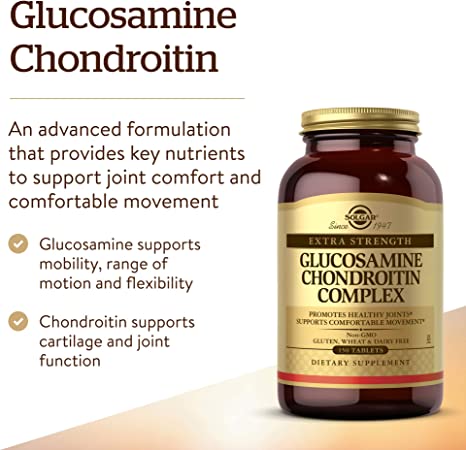In the body, there are several types of connective tissues. Cartilage, tendons, ligaments, intervertebral discs, pads between joints, and cellular membranes all are composed of connective tissue. All connective tissues have two common components, chief of which is collagen. One-third of the body’s total protein volume is composed of collagen, making it the most common protein in the body. The other component is proteoglycans (PGs). PGs form the “framework” for collagenous tissue.
These huge structural “macromolecules” are composed mainly of glycosaminoglycans (GAGs)—long chains of modified sugars.
The principal sugar in PGs is called hyaluronic acid, 50 percent of which is composed of glucosamine.

The principal amino acids forming collagen are proline, glycine, and lysine.
Collagen and PGs must somehow “get together” during the production of new connective tissue. Of the multitude of biochemical reactions that must take place during the synthesis of connective tissue, there is one critical “rate-limiting” step that, once reached, guarantees that new connective tissue is being successfully synthesized. That rate-limiting step is the conversion of glucose to glucosamine.
Glucosamine is the single most important substance in the synthesis of connective tissue.
More than 30 years of research has gone into understanding how glucosamine acts as the precursor of GAG synthesis.
Glucosamine is so effective, it repairs connective tissue and may very well be a way to reduce the risk of connective tissues problems from occurring in the first place by maintaining adequate connective tissues in your body. In human clinical trials, glucosamine given orally in doses of 750–1,500 milligrams daily was observed to initiate a reversal of connective tissue degeneration, promote connective tissue maintenance, and also reduce pain in the knee of athletes.
Glucosamine as a supplement clearly aids in connective tissue synthesis. All athletes need such a substance, as the repair and growth of connective tissue is never-ending. Research has confirmed that both glucosamine HCl and glucosamine sulfate are effective and may be useful for athletes to help maintain and promote healthy connective tissues and joints.
Research Reports More Benefits from
Taking G&CS Supplements
The more recent studies even show that taking G&CS supplements helps reduce joint space narrowing due to connective tissue wear-and-tear and can even prevent osteoarthritis from developing in the first place. Remember G&CS builds connective tissues, such as skin, tendons, ligaments, bone, and cartilage, which form the matrix that is involved in holding the entire body together. G&CS are made by the body similar to other metabolites, such as creatine, but active people (especially athletes) create a demand for these substances that can be greater than the body can supply.
Similar to glucosamine, chondroitin sulfate has been tested in humans as a promoter of connective tissue maintenance, growth, and repair. It is important to note that both glucosamine and CS are effective on their own.
Research has found that when taken together, they have a synergistic effect.
One issue with CS is the high-quality, standardized raw material is several times more expensive than glucosamine and unstandardized powdered forms of CS are.
Thus, glucosamine tends to be a cost-effective approach to promote connective health. People who do not respond to glucosamine supplementation after three months of use should consider using CS along with the glucosamine. There are even connective tissue supplements now sold for pets that you may know about from the advertising or may already be using for your pet.
Health Canada has approved-use monographs for glucosamine and CS. Some of the purposes and uses include:
- For Glucosamine Sulfate: Helps to relieve joint pain associated with osteoarthritis; Helps to relieve pain associated with osteoarthritis of the knee; Helps to protect against the deterioration of cartilage; and A factor in maintaining good cartilage and/or joint health. Adult dosage example is 1,500 milligrams per day, minimum four weeks to see beneficial effects.
- For Glucosamine Hydrochloride: A factor in maintaining healthy cartilage; Helps to maintain healthy cartilage; A factor in maintaining joint health; and Helps to maintain joint health. Adult dosage example is 1,500–2,000 milligrams per day, minimum four weeks to see beneficial effects.
- For Chondroitin Sulfate: Helps to relieve joint pain associated with osteoarthritis; and Helps to relieve pain associated with osteoarthritis of the knee. Adult dosage example is 800–1,200 milligrams per day, minimum of three months to see beneficial effects.
Consult the monographs for complete information for safe and effective use.



